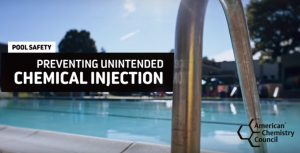Chlorine is indispensable to maintaining crystal clear, sanitized swimming pool water. However, when reports emerged that swimmers and pool staff were being accidentally exposed to chlorine gas at pools, there was a need to help stop these incidents. One incident of a chlorine gas exposure involved an equipment malfunction at a swim school in California that resulted in 19 people suffering breathing difficulties. Unfortunate exposures like these happen at the rate of at least a dozen or so per year in the US.
The problem starts when the water circulation pump and the chemical feed system do not operate in sync. If the water circulation pump stops, but the chemical feed equipment continues to add chemicals into the pipes, a chemical reaction can occur that produces gaseous chlorine. The gas then can find its way to the pool area once the circulation pump is restarted, potentially endangering swimmers and pool staff.
Recognizing a need to prevent these incidents, in late 2017, the American Chemistry Council’s Chlorine Chemistry Division brought together a group of swimming pool experts and stakeholders. The group included representatives of swimming pool associations, government health agencies, nonprofits, and pool chemical and equipment manufacturers. Their mission: to develop a video for pool operators demonstrating how to avoid the unintended exposure of pool patrons and staff to chlorine gas.
After nearly a year of work, the group produced a free video titled “Preventing Unintended Chemical Injection.” It details safeguards to help ensure the circulation pump and chemical feed system operate in unison, thus avoiding chlorine gas exposure. It also outlines best practices for pool staff in keeping swimmers out of the water when there is a risk of accidental exposure. The video debuted at the fall meeting of the World Aquatic Health Conference and the partnership is now promoting it widely to help put an end to accidental pool-related exposures to chlorine gas.
Through this collaboration, swimming pool operators now have a resource to help keep pools safer while chlorine chemistry continues to be used appropriately to help ensure healthy pools.
